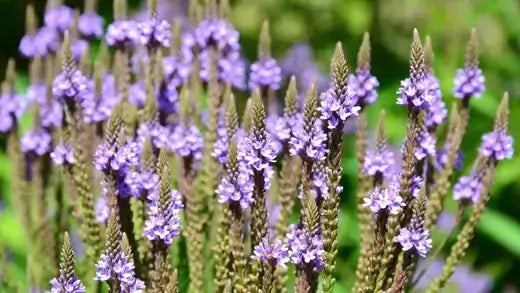Blue Vervain-Vervain hastata
This herb perennial is a versatile and fascinating herb with a rich history of traditional medicinal use.
This beautiful flowering plant belongs to the Verbenaceae family and is native to North America. It is often found in wetlands, meadows, streams, and rivers' edges.
Blue vervain is characterized by its striking blue or violet flowers that bloom in dense spikes, making it a valuable addition to gardens and a powerful herbal remedy with a wide range of healing characteristics.
The use of blue vervain in traditional medicine dates back centuries, with indigenous peoples of North America being among the first to recognize its medicinal properties. Native American tribes, such as the Cherokee and Iroquois, used various parts of the plant to treat various ailments.
The leaves and flowers were commonly employed to make infusions, poultices, and teas, which were used to address health issues ranging from fevers and respiratory complaints to digestive disorders and skin conditions.
Chemical Composition The healing characteristics of blue vervain can be attributed to its chemical composition, which includes various phytochemicals with therapeutic properties. Some of the critical constituents found in blue verbena include:
- Volatile Oils: Blue verbena contains essential oils with compounds like citral, limonene, and geraniol, contributing to its aromatic qualities and potential health benefits.
- Tannins: Tannins are naturally occurring polyphenolic compounds with antioxidant and astringent properties, which can benefit various health issues.
- Flavonoids: Flavonoids are a group of plants known for their antioxidant effects. Blue verbena contains several flavonoids, like quercetin and kaempferol, which can help protect cells from oxidative stress.
- Iridoids: These compounds have anti-inflammatory and antioxidant properties and are found in some species of verbena.
- Alkaloids: Some alkaloids in blue verbena may contribute to its potential therapeutic effects.
Healing Characteristics of Blue Verbena Blue verbena possesses a wide range of healing characteristics, making it a valuable herb in traditional and herbal medicine. Here are some of its most notable therapeutic properties and potential uses:
Anti-Inflammatory: Blue verbena has demonstrated anti-inflammatory properties, which could help reduce inflammation in conditions such as arthritis and muscle pain.
Antioxidant: The presence of flavonoids and other antioxidants in blue verbena makes it effective in combating oxidative stress slowing the risk of chronic diseases.
Digestive Health: Blue verbena has traditionally alleviated digestive issues like indigestion, bloating, and flatulence. Its mild astringent properties may help soothe the digestive tract.
Respiratory Health: Blue verbena can be beneficial for respiratory conditions. It has been used to relieve symptoms of colds, coughs, and bronchitis due to its anti-inflammatory and soothing effects on the respiratory system.
Fever Reduction: Native American tribes historically used blue verbena to lower fever, a practice that can be attributed to its potential antipyretic properties.
Wound Healing: The leaves of blue verbena were used topically as poultices to promote wound healing and alleviate skin irritations.
Stress and Anxiety: Some herbalists suggest that blue verbena may have mild calming and soothing effects, which can help reduce stress and anxiety.
Menstrual Support: Blue verbena has been used to address menstrual irregularities and discomfort, including cramps and bloating.
Immune Support: The antioxidant compounds in blue verbena can help support the immune system by protecting cells from damage caused by free radicals.
Detoxification: Blue verbena has been considered a mild detoxifying herb, potentially aiding in eliminating waste products from the body. Methods of Use Blue verbena can be utilized in various forms to harness its healing characteristics.
Here are some standard methods of preparation and use:
Tea: Blue verbena leaves and flowers can be steeped in hot water to make a calming herbal tea. This tea often addresses digestive issues, respiratory complaints, and stress. Tinctures are concentrated liquid extracts of blue verbena that dampen the herb in alcohol or glycerin. They are convenient for precise dosing and can be taken orally.
Poultices: For topical use, blue verbena leaves can be mashed or ground into a paste and applied directly to wounds, insect bites, or skin irritations to promote healing.
Infused Oil: Blue verbena can be infused into carrier oils like olive oil to create an herbal oil that can be used for massage or as a base for salves and balms.
Capsules and Supplements: Blue vervain supplements, often in capsule form, are available in some health stores and can be used for specific health goals. Safety and Precautions While blue vervain is generally considered safe when used in moderation, it's essential to exercise caution and consult with a healthcare professional before using it, especially if you are pregnant, nursing, or have underlying health conditions. Potential side effects may include gastrointestinal upset or skin irritation in sensitive individuals. As with any herbal remedy, it's crucial to source blue vervain from reputable suppliers to ensure product quality and purity. The proper dosage and preparation methods should be followed to maximize benefits and minimize risks.
Conclusion
Blue vervain, with its stunning blue flowers and rich medicinal history, offers a wealth of healing characteristics that have made it a valuable herb in traditional and herbal medicine. Blue vervain provides a versatile natural remedy for various health concerns, from its anti-inflammatory and antioxidant properties to its potential benefits for digestive, respiratory, and menstrual health. While blue vervain has a history of safe use, it's essential to approach its use carefully, seeking guidance from healthcare professionals and herbalists when necessary. With the proper precautions, blue vervain can be a valuable addition to your holistic health toolkit, providing physical and emotional support on your wellness journey.



